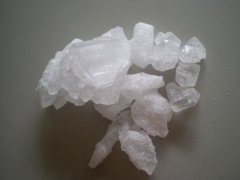Alum
| Infobox on Alum | |
|---|---|
| Example of Alum |  |
| Facts | |
| Origin | |
| Stowage factor (in m3/t) | 1,64 (casks, kegs) |
| Humidity / moisture | |
| Ventilation | |
| Risk factors | See text |
Alum
Description
Alum is a salt that in chemistry is a combination of an alkali metal, such as sodium, potassium, or ammonium and a trivalent metal, such as aluminum, iron, or chromium.
The most common form, potassium aluminum sulphate, or potash alum, is one form that has been used in food processing. Another, sodium aluminum sulphate, is an ingredient in commercially produced baking powder.
The potassium-based alum has been used to produce crisp cucumber and watermelon-rind pickles as well as maraschino cherries, where the aluminum ions strengthen the fruits’ cell-wall pectins.
Alums are useful for a range of industrial processes. They are soluble in water; have an astringent, acid, and sweetish taste; react acid to litmus; and crystallize in regular octahedra. When heated they liquefy; and if the heating is continued, the water of crystallization is driven off, the salt froths and swells, and at last an amorphous powder remains.
Potassium alum is the common alum of commerce, although soda alum, ferric alum, and ammonium alum are manufactured.
Aluminium sulphate is sometimes called alum in informal contexts, but this usage is not regarded as technically correct. Its properties are quite different from those of the set of alums formally described above.
In order to obtain alum from alunite, it is calcined and then exposed to the action of air for a considerable time. During this exposure it is kept continually moistened with water, so that it ultimately falls to a very fine powder. This powder is then lixiviated with hot water, the liquor decanted, and the alum allowed to crystallize. The alum schists employed in the manufacture of alum are mixtures of iron pyrite, Aluminium Silicate and various bituminous substances, and are found in upper Bavaria, Bohemia, Belgium and Scotland. These are either roasted or exposed to the weathering action of the air. In the roasting process, sulfuric acid is formed and acts on the clay to form aluminium sulphate, a similar condition of affairs being produced during weathering. The mass is now systematically extracted with water, and a solution of aluminium sulphate of specific gravity 1.16 is prepared. This solution is allowed to stand for some time (in order that any calcium sulphate and basic ferric sulphate may separate), and is then evaporated until Ferrous sulphate crystallizes on cooling; it is then drawn off and evaporated until it attains a specific gravity of 1.40. It is now allowed to stand for some time, decanted from any sediment, and finally mixed with the calculated quantity of potassium sulfate (or if ammonium alum is required, with ammonium sulphate), well agitated, and the alum is thrown down as a finely-divided precipitate of alum meal. If much iron should be present in the shale then it is preferable to use potassium chloride in place of potassium sulphate.
In the preparation of alum from clays or from bauxite, the material is gently calcined, then mixed with sulphuric acid and heated gradually to boiling; it is allowed to stand for some time, the clear solution drawn off and mixed with acid potassium sulphate and allowed to crystallize. When cryolite is used for the preparation of alum, it is mixed with calcium carbonate and heated. By this means, sodium aluminate is formed; it is then extracted with water and precipitated either by Sodium Bicarbonate or by passing a current of carbon dioxide through the solution. The precipitate is then dissolved in sulfuric acid, the requisite amount of potassium sulphate added and the solution allowed to crystallize.
Application
Alum is used in vaccines as an adjuvant. Alum is commonly used as a coagulant in water treatment. It is also used for various other purposes, including dyeing, tanning and printing.
Shipment / Storage
A white crystalline substance shipped in canvas bags.
Carries a large percentage of water which may be lost through rise in temperature and drop in humidity. May be subject to loss in weight due to loss of moisture. The effect of this is a powder formation on the crystals, with occasionally a complete breakdown of the crystals to a fine powder.
There is, however, no fundamental chemical change. Bags are prone to rotting and tearing, with subsequent loss of weight. Should be stowed away from goods susceptible to moisture, and kept clear of textile goods.
Risk factors
- Moisture damage
- Loss of moisture/weight
- Contamination
- Foreign odour











